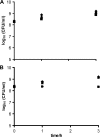Influence of sublethal concentrations of common disinfectants on expression of virulence genes in Listeria monocytogenes
- PMID: 19897753
- PMCID: PMC2798637
- DOI: 10.1128/AEM.00925-09
Influence of sublethal concentrations of common disinfectants on expression of virulence genes in Listeria monocytogenes
Abstract
Listeria monocytogenes is a food-borne human pathogen that causes listeriosis, a relatively rare infection with a high fatality rate. The regulation of virulence gene expression is influenced by several environmental factors, and the aim of the present study was to determine how disinfectants used routinely in the food industry affect the expression of different virulence genes in L. monocytogenes when added at sublethal concentrations. An agar-based assay was developed to screen the effect of disinfectants on virulence gene promoter expression and was validated at the transcriptional level by Northern blot analysis. Eleven disinfectants representing four different groups of active components were evaluated in this study. Disinfectants with the same active ingredients had a similar effect on gene expression. Peroxy and chlorine compounds reduced the expression of the virulence genes, and quaternary ammonium compounds (QAC) induced the expression of the virulence genes. In general, a disinfectant had similar effects on the expression of all four virulence genes examined. Northern blot analyses confirmed the downregulation of prfA and inlA expression by Incimaxx DES (a peroxy compound) and their upregulation by Triquart Super (a QAC) in L. monocytogenes EGD. Hence, sublethal concentrations of disinfectants routinely used in the food industry affect virulence gene expression in the human pathogen L. monocytogenes, and the effect depends on the active components of the disinfectant. From a practical perspective, the study underlines that disinfectants should be used at the lethal concentrations recommended by the manufacturers. Further studies are needed to elucidate whether the changes in virulence gene expression induced by the disinfectants have impact on virulence or other biological properties, such as antibiotic resistance.
Figures





Similar articles
-
Tolerance to quaternary ammonium compound disinfectants may enhance growth of Listeria monocytogenes in the food industry.Int J Food Microbiol. 2017 Jan 16;241:215-224. doi: 10.1016/j.ijfoodmicro.2016.10.025. Epub 2016 Oct 21. Int J Food Microbiol. 2017. PMID: 27810443
-
Industrial disinfectants do not select for resistance in Listeria monocytogenes following long term exposure.Int J Food Microbiol. 2012 Nov 1;160(1):11-5. doi: 10.1016/j.ijfoodmicro.2012.09.009. Epub 2012 Sep 23. Int J Food Microbiol. 2012. PMID: 23141640
-
Large-scale phenotypic and genomic analysis of Listeria monocytogenes reveals diversity in the sensitivity to quaternary ammonium compounds but not to peracetic acid.Appl Environ Microbiol. 2025 Apr 23;91(4):e0182924. doi: 10.1128/aem.01829-24. Epub 2025 Mar 4. Appl Environ Microbiol. 2025. PMID: 40035557 Free PMC article.
-
Biocide use in the food industry and the disinfectant resistance of persistent strains of Listeria monocytogenes and Escherichia coli.Symp Ser Soc Appl Microbiol. 2002;(31):111S-120S. Symp Ser Soc Appl Microbiol. 2002. PMID: 12481836 Review.
-
Tolerance of Listeria monocytogenes to biocides used in food processing environments.Food Microbiol. 2021 Aug;97:103758. doi: 10.1016/j.fm.2021.103758. Epub 2021 Feb 3. Food Microbiol. 2021. PMID: 33653529 Review.
Cited by
-
Comparison of Gene Expression Profiles of Uropathogenic Escherichia Coli CFT073 after Prolonged Exposure to Subinhibitory Concentrations of Different Biocides.Antibiotics (Basel). 2019 Sep 27;8(4):167. doi: 10.3390/antibiotics8040167. Antibiotics (Basel). 2019. PMID: 31569631 Free PMC article.
-
Degradation of Listeria monocytogenes biofilm by phages belonging to the genus Pecentumvirus.Appl Environ Microbiol. 2024 Mar 20;90(3):e0106223. doi: 10.1128/aem.01062-23. Epub 2024 Feb 5. Appl Environ Microbiol. 2024. PMID: 38315006 Free PMC article.
-
Chitinase Expression in Listeria monocytogenes Is Influenced by lmo0327, Which Encodes an Internalin-Like Protein.Appl Environ Microbiol. 2017 Oct 31;83(22):e01283-17. doi: 10.1128/AEM.01283-17. Print 2017 Nov 15. Appl Environ Microbiol. 2017. PMID: 28887418 Free PMC article.
-
Investigating Transcriptomic Induction of Resistance and/or Virulence in Listeria monocytogenes Cells Surviving Sublethal Antimicrobial Exposure.Foods. 2021 Oct 8;10(10):2382. doi: 10.3390/foods10102382. Foods. 2021. PMID: 34681431 Free PMC article.
-
Asymptomatic Carriage of Listeria monocytogenes by Animals and Humans and Its Impact on the Food Chain.Foods. 2022 Nov 1;11(21):3472. doi: 10.3390/foods11213472. Foods. 2022. PMID: 36360084 Free PMC article. Review.
References
-
- Aase, B., G. Sundheim, S. Langsrud, and L. M. Rørvik. 2000. Occurrence of and a possible mechanism for resistance to a quaternary ammonium compound in Listeria monocytogenes. Int. J. Food Microbiol. 62:57-63. - PubMed
-
- Böckmann, R., C. Dickneite, B. Middendorf, W. Goebel, and Z. Sokolovic. 1996. Specific binding of the Listeria monocytogenes transcriptional regulator PrfA to target sequences requires additional factor(s) and is influenced by iron. Mol. Microbiol. 22:643-653. - PubMed
Publication types
MeSH terms
Substances
LinkOut - more resources
Full Text Sources

